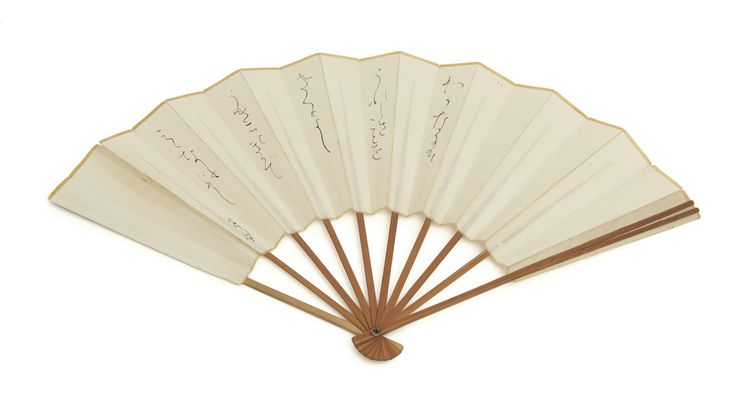A bamboo and paper folding fan (ōgi) in scribed by the Buddhist Nun Otagaki Rengetsu (1791-1875)
Bamboo and paper folding fan (ōgi) inscribed by the Buddhist nun Otagaki Rengetsu (1791-1875) with one of her waka-poems:
Wakaba ni wa ureshiki koto o kiku mo yoshi uki koto kikade miminashi mo yoshi:
Biography of Otagaki Rengetsu
When thirty-three years old Otagaki Nobu had already buried two husbands and two children. She renounced the world and became a nun and used from then on the name Rengetsu (Lotus-Moon). She did not enter a convent but lived on her own at the precincts of a number of temples. Gradually she lived the life of a recluse literati sustaining herself with calligraphies (written in a very fine hand with a thin brush) of her own waka-poems occasionally accompanied by a small drawing. Although an able poet, her waka-poems which were later gathered in the only book that appeared during her life (Ama no karumo, 1870) are rather traditional and continue the heritage of a thousand years of waka-poetry.
More remarkable was her pottery which became a huge success, so much so that it was said that eventually most people in Kyoto owned one of her piece. She mainly made tea bowls (chawan) for chanoyu. These bowls are rather large as tea is made with a tea whisk and tea sets consisting of a small tea pot, five small tea cups and a water cooler (looking as if made from lotus leaves) used in sencha tea drinking. This is a far more informal form of enjoying tea than the tea ceremony chanoyu. She decorated her tea ware also with her own poems, written with a brush but more often carved in the clay. She also made other types of pottery such as vases or water pots.
When around sixty years old, she became acquainted with the young Tomioka Tessai (1837-1924) who came to live with her as a kind of pageboy. When she once again moved in 1862, she left her small house to him though they still worked together. When she turned seventy-five she started to live at a house at the Jinkō’in in the north of Kyoto which turned out to be her last abode.
Around 1860 copies of her work appeared on the market. It was rumoured that she was often so kind to help forgers when they had difficulties with her handwriting and wrote herself poems on fake pottery!
Eventually Tomioka Tessai who painted the best known portrait of Rengetsu became the last great literati painter of Japan, known for his paintings in a very individual style often accompanied by Chinese poems or an inscription in Chinese.



